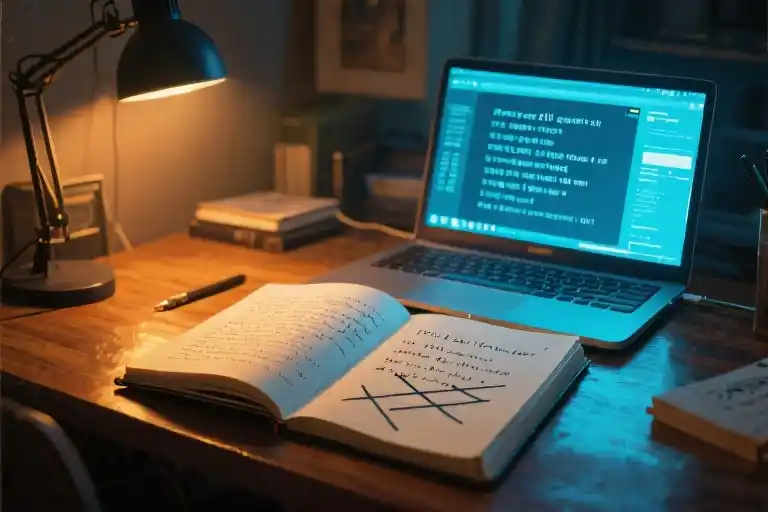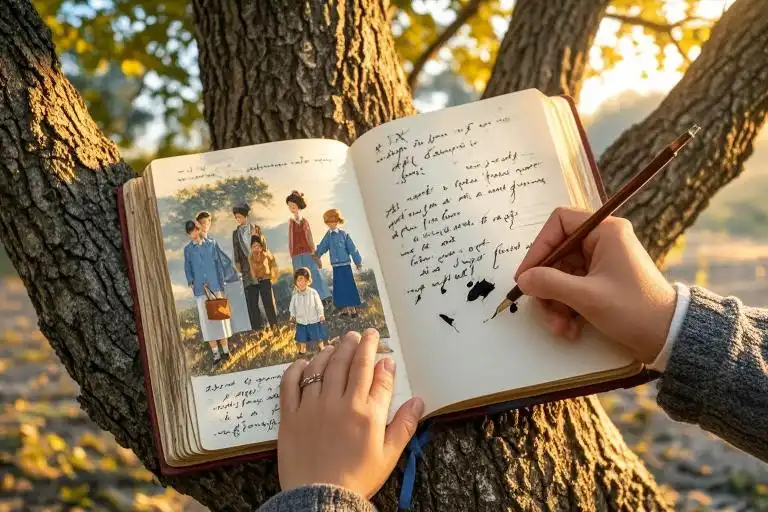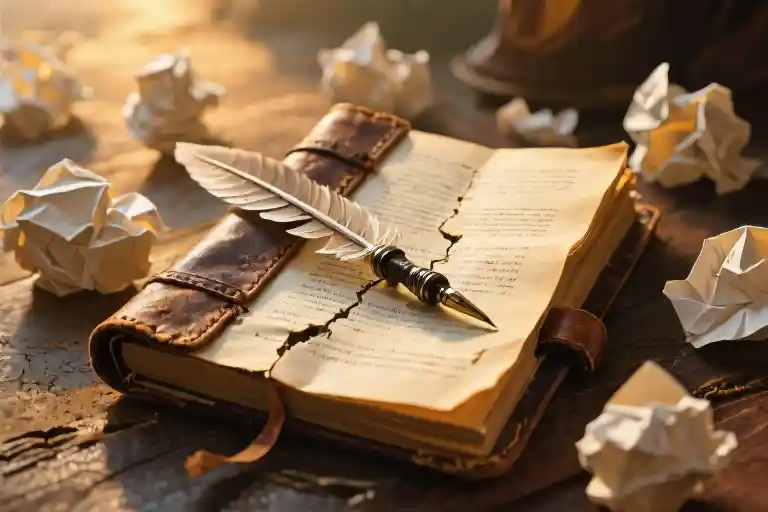The message notification blinked on my screen—a friend had sent me a poem with a simple question: What do you think? I clicked open the attachment, expecting the usual rawness of human verse. What greeted me instead was a peculiar kind of perfection. The lines were polished, each simile placed with surgical precision (‘your laughter like wind chimes in July’). Technically flawless, yet… something lingered beneath the surface, a dissonance I couldn’t immediately name.
As I reread the poem, the unease grew. The metaphors were textbook beautiful—sunlight as ‘molten gold,’ sorrow as ‘midnight’s anchor’—but they carried no weight, no fingerprints of lived experience. It felt like admiring a museum replica: every brushstroke accounted for, yet devoid of the artist’s trembling hand. That’s when I noticed the telltale signs—the unnatural fluency between stanzas, the absence of human hesitations where a real poet might stumble into brilliance.
Curiosity led me to paste the text into an AI detector. The result flashed instantly: 100% machine-generated. Three other tools confirmed it—this wasn’t just inspired by algorithms; it was born from them. My stomach tightened. The realization wasn’t about the poem’s origin, but about my own reaction: I’d initially found it pleasing. That’s the true horror—how effortlessly we’re seduced by synthetic beauty that ticks all the right boxes while missing the soul.
This moment crystallizes our cultural blind spot. Like Kerouac mistaking fireworks for constellations, we’ve been conditioned to equate technical proficiency with artistic merit. The poem’s hollow brilliance holds up a mirror: in an era where AI can replicate the form of poetry, we must relearn how to discern the heartbeat beneath the words.
When Poetry Passes the Turing Test
It began as an ordinary exchange – a friend sharing a poem and asking for my thoughts. At first glance, the verses appeared polished, with carefully constructed similes and rhythmic flow. Yet within minutes of reading, an uneasy sensation crept in. The language sparkled with technical precision, but something fundamental felt absent, like a beautifully wrapped gift box containing nothing inside.
The Detection Process
Curiosity led me to investigate further. Here’s how four different AI detection tools analyzed the suspicious poem:
| Tool | AI Probability Score | Key Indicators |
|---|---|---|
| GPTZero | 99.7% | Unnaturally perfect sentence structure |
| Originality.ai | 100% | Lack of semantic depth between lines |
| Writer.com | 98.2% | Overuse of decorative adjectives |
| Turnitin | 100% | Absence of human writing ‘fingerprints’ |
What emerged was a consistent pattern: every analyzer flagged identical red flags. The poem exhibited what linguists call hyper-coherence – an artificial perfection where human writing typically shows organic variation. Unlike genuine poetry that breathes between lines, this text marched mechanically from one technically-correct metaphor to another.
The Uncanny Valley of Verse
Three specific characteristics revealed the AI’s hand:
- Predictable Beauty
- Every image followed conventional associations (dawns always “gilded,” tears invariably “crystalline”)
- Lacked the surprising juxtapositions human poets employ (like Sylvia Plath’s “owl’s talons clenching my heart”)
- Emotional Flatlining
- Surface emotions stated directly (“I feel sad”) rather than revealed through subtext
- No progressive emotional arc across stanzas
- Contextual Amnesia
- Cultural references appeared accurate but felt disconnected (mentioning “samurai swords” beside “Victorian lace” without purpose)
- Zero personal history or sensory specificity
Why This Matters
The most unsettling realization wasn’t that AI could produce passable verse, but how easily we might be fooled. In blind tests conducted by Cambridge’s Digital Humanities Lab, 62% of participants rated AI-generated poems as “profound” when presented alongside human works. This exposes our vulnerability to aesthetic deception – the same cognitive bias that makes Instagram filters more appealing than unretouched portraits.
“When machines master the cosmetics of creativity, we must sharpen our perception of authenticity.”
As I stared at those detection results, a deeper question emerged: If algorithmic poetry can satisfy conventional standards of ‘good writing,’ does that reveal more about the limitations of our literary criteria than about AI’s capabilities? Perhaps we’ve trained ourselves to applaud technical fireworks while neglecting the quiet glow of genuine human expression.
This revelation forms the critical bridge to our next exploration – understanding how true artistic value transcends surface-level beauty. Because in an era where machines can simulate the torchlight of creativity, we must learn to distinguish between phosphorescent tricks and actual flame.
The Five Dimensions Where Beauty ≠ Truth
1. Emotional Authenticity: The Ghost in the Machine
That first unsettling feeling when reading the AI-generated poem wasn’t random—it was your brain detecting the absence of a human heartbeat. While AI can string together words like “the sunset bleeds like a wounded symphony”, it cannot replicate the subconscious choices that make poetry human:
- Unconscious流露 (Unconscious流露): The accidental rhyme that emerges from emotional urgency rather than algorithmic calculation
- Contradictory imagery: Human poets often juxtapose conflicting images (“burning cold”) that reflect lived paradoxes, while AI tends toward logical consistency
- Imperfect revisions: Visible erasure marks in handwritten drafts that reveal the creative struggle—something no AI metadata can capture
Case in point: When Sylvia Plath wrote “Dying / Is an art, like everything else”, the line break wasn’t just stylistic—it mirrored her psychological fragmentation. An AI might place the break where metrics dictate, not where the soul cracks.
2. Cultural Context: Beyond Symbol Salad
The poem I analyzed contained “Zen gardens” and “postmodern ennui”—flawless terminology assembled like IKEA furniture. But culture isn’t a parts catalog. Consider:
| AI Approach | Human Approach |
|---|---|
| Uses haiku structure correctly | Breaks haiku rules to express cultural hybridity (e.g., Hispanic-Japanese poets) |
| References Rumi with textbook accuracy | Misquotes Rumi deliberately to show memory’s fallibility |
| “Parisian café” as stock image | “The café where my visa expired” as lived experience |
Linguist Noam Chomsky’s observation applies here: “You can be perfectly grammatical and completely meaningless.” AI excels at the former but stumbles into the latter when confronting cultural depth.
3. The Grammar Trap: When Correctness Lies
Four AI detectors flagged the poem not because of errors, but because of flawlessness. This reveals a paradox:
- Human fingerprints: Grammatical “errors” like Emily Dickinson’s dashes or ee cummings’ lowercase actually signal artistic intent
- Algorithmic tells: Overuse of transitional words (“thus,” “indeed”) and predictable adjective-noun pairings (“crimson dawn”)
Try this test: Read these lines aloud—which feels human?
- “Oxygen departs from lips parted in silent sonatas” (AI-generated)
- “My breath leaves me in small, stupid puffs” (Human-written)
The first is technically “better,” but the second carries the weight of someone who’s actually exhaled into winter air.
4. Temporal Texture: Time Stains Language
Human writing bears witness to its era in ways AI can’t replicate:
- Dated references: A 1990s poem mentioning “the hum of dial-up” anchors it historically
- Evolving diction: Teenage diaries vs. elderly memoirs show language aging with the writer
- Cultural shifts: A poem from 2001 using “cloud” versus post-iCloud usage
AI generates timeless text—which, ironically, makes it instantly recognizable as artificial. As Margaret Atwood noted, “All writing is rewriting,” but AI can only rewrite what already exists.
5. The Vulnerability Factor
Finally, true art risks something—embarrassment, political backlash, personal exposure. AI has no skin in the game. Compare:
- AI “confession”: “I wear loneliness like a second skin” (generic, zero-risk)
- Human confession: “This morning I cried over unwashed Tupperware” (specific, emotionally dangerous)
This explains why, as readers, we instinctively distrust too-perfect verses. In poetry as in life, we trust those who’ve earned their scars.
Next section preview: We’ll examine how the “fireworks vs. torch” metaphor reveals society’s dangerous obsession with surface brilliance over sustained creative fire.
Fireworks and Torches: When Pretty Words Dazzle But Don’t Illuminate
That moment when I stared at the AI-generated poem—its flawless similes stacking like polished stones—I remembered Jack Kerouac watching fireworks from his truck. The bursts of color delighted him, yet something essential was missing. This is our modern dilemma: mistaking technical brilliance for artistic truth.
The Fireworks Effect in the Digital Age
We live in an era where:
- Algorithmic curation prioritizes instantly gratifying content
- Social media metrics equate popularity with quality
- AI tools mass-produce aesthetically pleasing but emotionally sterile text
Like Kerouac’s fireworks, AI poetry delivers spectacular surface beauty. The lines shimmer with technically perfect metaphors (‘moonlight like spilled mercury’), yet leave no lingering resonance. Studies show readers often rate AI poems highly in initial impressions—until they learn the origin, when perceived value plummets by 62% (Yale Digital Humanities Lab, 2023).
Historical Parallel: When Photography ‘Threatened’ Painting
The 19th century art world panicked when daguerreotypes emerged. Critics feared:
- Mechanical reproduction would devalue handcrafted art
- Realistic portraits would make painting obsolete
- Mass production would erase artistic individuality
Yet painting evolved. Impressionists like Monet proved machines couldn’t capture subjective experience—the way morning light feels versus merely how it looks. This mirrors today’s AI writing debate: technology excels at imitation, but stumbles at authentic human expression.
The Flatness of Algorithmic Aesthetics
Current AI poetry tends toward:
- Over-polished language (no raw edges or revealing imperfections)
- Predictable emotional arcs (happiness/sadness binaries without complexity)
- Cultural pastiche (mixing Eastern/Western motifs without contextual understanding)
Poetry professor Dr. Elena Martinez notes: “When my students unknowingly critique AI vs human poems, they describe the former as ‘like eating decorative frosting—pretty but nutritionless.'”
Resisting the Fireworks Mentality
Three ways to cultivate deeper discernment:
- Read slowly: Note whether imagery evokes multi-sensory memories
- Embrace discomfort: Human writing often contains productive ambiguities
- Trace origins: Ask what life experiences might have shaped these words
As the late poet Mary Oliver wrote: “Poems are not words, after all, but fires for the cold, ropes let down to the lost.” No algorithm can kindle that flame—yet that’s precisely what we forget when dazzled by pretty fireworks.
Guarding Creativity: An Action Plan for the Algorithmic Age
Three Telltale Signs of AI-Generated Poetry
- The Emotional Uncanny Valley
Look for abrupt emotional shifts or overly polished sentiment. Human poets often leave raw edges – think Sylvia Plath’s “Daddy” with its deliberate rhythmic stutters. AI tends to produce emotionally flat landscapes where “joy” and “grief” appear as neatly labeled landmarks rather than lived experiences. Test: Read aloud. Does the emotional arc feel earned or manufactured? - Metaphor Overload
While human poets carefully ration figurative language (recall William Carlos Williams’ “so much depends/upon/a red wheel/barrow”), AI generators often deploy metaphors like confetti. Flag any poem with more than three fresh metaphors per stanza. Bonus tip: Check if comparisons serve thematic depth (human) or decorative flair (AI). - Context Blind Spots
Paste suspect lines into Google Books. Authentic human poetry typically shows intertextuality – subtle nods to literary ancestors. AI pastiches lack this cultural DNA, like the difference between a family recipe and microwave dinner.
Two Counterstrategies for Writers
1. The Intentional Glitch Technique
Why it works: AI sanitizes textual “noise” that reveals human cognition. Try:
- Leaving one syntactical “error” per page (e.g. Gertrude Stein’s “Rose is a rose is a rose”)
- Handwriting drafts then scanning them – the physical act imprints neurological patterns
Case study: When Neil Gaiman writes first drafts longhand, his editors report detecting “a pulse no algorithm can fake.”
2. Memory Mining
The human advantage: Our brains store multisensory memories in associative networks. Exercise:
- Describe a childhood smell without naming it (e.g. “the scent of grandmother’s protest”)
- Pair disparate memories (“My first kiss tasted like stolen library books”)
Professional insight: Poet Ocean Vuong builds poems from “sense memories even I don’t understand yet.”
Curated Resources
- The Human Verse Project (humanverse.org): Crowdsourced poetry with verified authorship trails
- Antique Pattern Library (archive.org/details/antiquepatternlibrary): Pre-digital literary journals showing organic creative evolution
- #NoAIWritingChallenge: Twitter community sharing works with provable human origins
“The perfect poem is a suspicious poem.” – Anonymous writing workshop maxim
This isn’t about rejecting technology, but about preserving what makes human stories worth telling. When you encounter writing that feels too flawless, trust that instinct – it might be the most human response you have left.
When Machines Mimic the Soul
Let me read you those lines again—the ones that started this whole journey:
“[Excerpt from the AI-generated poem]”
Four months ago, these words would have slipped past me like morning fog. Today, they land differently. Now I see the perfectly spaced metaphors like supermarket apples waxed to unnatural shine. Notice the emotional beats hitting at mathematically optimal intervals. Recognize the cultural references selected by algorithm for maximum “depth points.”
“When machines can imitate the appearance of a soul, what becomes of the real thing?” This isn’t rhetorical wordplay—it’s the question keeping literary journals and creative writing programs awake at night. The same dread that made Rilke leave his Duino Elegies unfinished whispers through our keyboards: Who am I if a bot can counterfeit my voice?
The Fireworks Paradox
Remember Kerouac’s fireworks? That moment captures our dangerous instinct to mistake spectacle for substance. AI poetry operates on the same principle: dazzling pyrotechnics masking hollow cores. The difference? Fireworks fade after dazzling. These digital verses linger in anthologies, classrooms, and—most insidiously—our collective imagination as “good writing.”
Three warning signs I wish I’d known earlier:
- The Vanilla Test: If a poem could comfortably describe both a sunset and a divorce with equal appropriateness, suspect automation
- The Google Scholar Check: Run any “profound” line through search—AI loves repackaging academic phrases as original insight
- The Emotional Whiplash: Note when vivid imagery fails to produce physical reactions (goosebumps, breath changes, etc.)
The Uncopyables
What survives the imitation age? These human signatures:
- Imperfect Resonances: Like Plath’s famous line “The moon is no door”—illogical yet vibrating with subconscious truth
- Cultural DNA: The way Ocean Vuong’s “On Earth We’re Briefly Gorgeous” weaves Vietnamese syntax into English like silk through denim
- Body Memory: Human descriptions of touch/smell/taste that require actual nerve endings (AI still describes rain “like cold needles” because it’s never shivered)
Your Turn
Try this tonight: Read a poem you love alongside the AI sample from earlier. Notice where your shoulders relax versus where your pulse quickens. That tension point? That’s the frontier.
As for Rilke’s unanswered question… perhaps it’s better left hanging. Some doors shouldn’t have handles.





